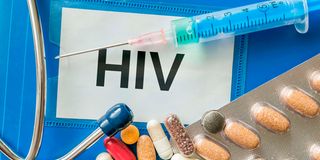Prices of lifesaving HIV drug slashed

The move to reduce HIV drug price by 25 per cent comes as a result of a successful negotiation deal between GF and pharmaceutical firms that manufacture generic drugs.
What you need to know:
- TLD is a generic three-in-one HIV treatment regimen comprising tenofovir disoproxil, lamivudine and dolutegravir.
- It was recommended by the World Health Organization in 2019 as the preferred first-line and second-line treatment for all populations including expectant women and those with potential to bear children.
- Other than having less side effects, TLD is easier to take and it also suppresses HIV.
People living with HIV can now breathe a sigh of relief after Global Fund (GF) secured a deal that will see patients pay as little as Sh6,000 annually for first-line treatment.
In an announcement made last week, the international firm disclosed that patients will now be able to obtain the lifesaving pill known as TLD for Sh6,543 yearly.
The move to reduce HIV drug price by 25 per cent comes as a result of a successful negotiation deal between GF and pharmaceutical firms that manufacture generic drugs.
Global Fund is an international financing organisation established in 2002 with an aim of combating malaria, tuberculosis and Aids.
“The pricing improvement will enable governments in less developed nations to extend access to critical services for HIV treatment,” read a presser by GF.
TLD is a generic three-in-one HIV treatment regimen comprising tenofovir disoproxil, lamivudine and dolutegravir.
It was recommended by the World Health Organization (WHO) in 2019 as the preferred first-line and second-line treatment for all populations including expectant women and those with potential to bear children.
Other than having less side effects, TLD is easier to take and it also suppresses HIV.
GF boss Peter Sands noted that “millions of people battling HIV are still unable to access quality treatment particularly in nations with high prevalence of the disease which are constrained financially.”
“TLD price reduction means the government and other grant partners working with GF can now constrain new infections and save more lives by channeling more prevention investments and expanding treatment programs,” clarified Sands.
Licensing agreements struck in 2017 made it possible for over 19 million people living with HIV in low and middle-income nations to access TLD each for up to Sh10,912 yearly.
This unprecedented pricing level, at the time, was achieved through collaboration between GF and various stakeholders such as Bill & Melinda Gates Foundation and The Joint United Nations Programme on HIV/AIDS.
WHO’s recommendation around four years ago followed new data that quelled fears over the safety of HIV drug dolutegravir (DTG).
Preliminary findings had raised the alarm over the possibility of expectant women using DTG delivering infants with brain and spinal cord birth defects (neural tube defects).
Neural tube defects are the major causes of spina bifida, a birth defect where spinal nerves and spinal cord are left partially exposed through a back opening after a section of the spinal column fails to form properly.
Four neural tube defects cases were reported out of 426 women who conceived while taking the DTG drug in a survey released in Botswana on May 2018.
Consequently, nations recommended efavirenz (EFV) for HIV treatment among women with potential to bear children and mothers to be as opposed to DTG.
However, two extensive clinical trials that sought to contrast DTG and EFV in terms of efficacy and safety use in Africa expanded the evidence scope.
Contrary to the previous survey, the latest findings found a significantly lower risk of neural tube defects.
DTG was also found to be more effective, has less side effects and is easier to take than presently used alternative HIV drugs, stated the experts.
With increasing resistance of the virus to nevirapine and EFV based treatments, DTG has a higher barrier genetically to developing drug resistance.
A 2019 survey conducted by WHO found resistance levels of the pre-treatment drug to be higher than 10 per cent which is the recommended threshold in 12 out of 18 countries.
The findings could have prompted the health authority to update the guidelines even as it highlights the need to continue monitoring the risk of contracting neural tube defects linked to DTG.





